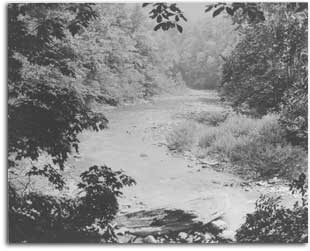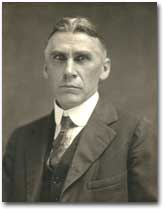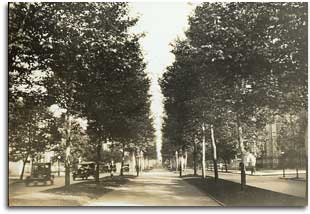Celebrating the Centennial of Forestry and Parks in Maryland 1906-2006
 Maryland was a leader among the states in establishing a program of forest conservation, and out of that forest conservation initiative, Maryland’s system of state parks emerged almost immediately.
Maryland was a leader among the states in establishing a program of forest conservation, and out of that forest conservation initiative, Maryland’s system of state parks emerged almost immediately.
In 1906, philanthropist brothers John and Robert Garrett challenged the state to establish a forestry program by donating nearly 2000 tree-stripped acres of land in Garrett County to the state on the condition that the state establish the governmental machinery to promote wise use of forest resources. At that time, Maryland’s tree cover had been reduced from nearly 90 percent of its land surface when the first colonists arrived to a paltry 35 percent. Maryland was running out of wood, losing wildlife habitat, suffering the ravages of erosion and stream siltation, and being scourged by unchecked forest fires.
The state legislature, spurred by Senators William McCulloh Brown and Joseph B. Seth, with the aid of State Geologist W. Bullock Clark, responded with Maryland’s first forestry law, which Governor Edwin Warfield signed into law on April 5, 1906. Maryland was thus the third state in the union, preceded by Pennsylvania and Wisconsin, to establish a statewide forestry program.
 The law established a Board of Forestry, made up of influential Marylanders, to oversee the management of the Garrett bequest, to institute a statewide program of forest conservation, to accept additional land donations, and to hire a state forester. Acting upon the board’s recommendation, Governor Warfield appointed an able young forester working for the U.S. Forest Service, Fred W. Besley (pictured on the left), who would serve as Maryland’s first State Forester from 1906 until 1942. A Yale School of Forestry trained protégé of Gifford Pinchot, first U.S. Forester, Besley proved to be an able and energetic choice.
The law established a Board of Forestry, made up of influential Marylanders, to oversee the management of the Garrett bequest, to institute a statewide program of forest conservation, to accept additional land donations, and to hire a state forester. Acting upon the board’s recommendation, Governor Warfield appointed an able young forester working for the U.S. Forest Service, Fred W. Besley (pictured on the left), who would serve as Maryland’s first State Forester from 1906 until 1942. A Yale School of Forestry trained protégé of Gifford Pinchot, first U.S. Forester, Besley proved to be an able and energetic choice.
Besley realized almost immediately that one good way to promote the forestry agenda was to encourage the public to use forest reserves for recreational purposes. When, in 1907, John Glenn, a resident of Catonsville, donated the beginnings of another forest reserve along the Patapsco River near Baltimore, Besley saw the opportunity to entice Baltimore area residents to come recreate in the great out-of-doors, and by 1910 was informally calling the Patapsco Forest Reserve “Patapsco Park.” By 1912, Besley had developed a small recreation area along the river, and by the middle of the decade, people were flocking out of Baltimore to picnic, swim and camp at the “park.” Now a 14,000 acre, 32 mile long stretch of public land, Patapsco Valley State Park hosts over a half million visitors a year.
 Besides establishing additional forest reserves and parks, Fred W. Besley taught forestry practices at the University of Maryland and established the first state tree nursery there. He also traveled, in his words, “every cow path in Maryland” producing a comprehensive inventory of all tree stands in the state that exceeded 5 acres. He gave illustrated talks to farmers, lumbermen, public service groups, and to anyone who would listen, on the benefits of wise forest management. He and his small staff provided advice to wood lot owners on how best to manage their forest resources, and created a roadside tree program to beautify Maryland’s growing network of public highways. Most significantly, Besley created a staff of over 300 volunteer forest wardens, along with a network of more than 40 fire towers, across the state to reduce the incidence of forest fires, an effort at which the wardens succeeded splendidly. After the legislature started providing money for forest reserve acquisition, Besley purchased historic Fort Frederick, a relic of the French and Indian War (1756-1763), which, like Patpasco, was informally known as a park. He thus earned the gratitude of people who wanted the ruined fort preserved in the public interest.
Besides establishing additional forest reserves and parks, Fred W. Besley taught forestry practices at the University of Maryland and established the first state tree nursery there. He also traveled, in his words, “every cow path in Maryland” producing a comprehensive inventory of all tree stands in the state that exceeded 5 acres. He gave illustrated talks to farmers, lumbermen, public service groups, and to anyone who would listen, on the benefits of wise forest management. He and his small staff provided advice to wood lot owners on how best to manage their forest resources, and created a roadside tree program to beautify Maryland’s growing network of public highways. Most significantly, Besley created a staff of over 300 volunteer forest wardens, along with a network of more than 40 fire towers, across the state to reduce the incidence of forest fires, an effort at which the wardens succeeded splendidly. After the legislature started providing money for forest reserve acquisition, Besley purchased historic Fort Frederick, a relic of the French and Indian War (1756-1763), which, like Patpasco, was informally known as a park. He thus earned the gratitude of people who wanted the ruined fort preserved in the public interest.
With the acquisition of state-owned forest lands came the necessity of paid employees to watch over it. By 1916, Besley had two salaried “resident forest wardens” on duty, Edmund G. Prince of the Patapsco Reserve and Abraham Lincoln Sines of the Potomac Reserve (now Garrett State Forest in Garrett County). As more lands were acquired, with some dedicated for recreational use, it eventually became necessary to hire forest and park guards to assist the wardens with protecting the resources and assisting the public in the use and enjoyment of forests and parks. Out of this early workforce has grown today’s force of professional resource managers, forest and park rangers, technicians, conservation aids and other forest and park resource specialists.
The Great Depression of the 1930s, as devastating as it was to the nation as a whole, proved a boon to forest and park development. One of President Franklin D. Roosevelt’s New Deal programs was the Civilian Conservation Corps, which, in Maryland, put 30,000 young unemployed men to work reclaiming forest and other natural resources, building recreational facilities and restoring historic structures on public lands. Most of the recreational facilities that the CCC built in Maryland forests and parks are in use today. Besley later stated that all the good works of the CCC set Maryland’s forests and parks ahead by 20 years.
During the Second World War, despite the drain of manpower to the military, public demand for outdoor recreation remained constant, then accelerated after the war as prosperity returned.
Potomac State Forest Garrett County, Maryland